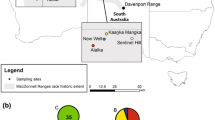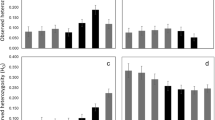Abstract
The endangered Socorro Isopod, Thermosphaeroma thermophilum, is endemic to a single thermal spring in Socorro, NM. This species is cannibalistic, with males more cannibalistic than females, and with females and juveniles more vulnerable than males as prey. In 1990, the New Mexico Department of Game and Fish, created the Socorro Isopod Propagation Facility (SIPF) near the natural habitat, Sedillo Spring (SS), to increase total population size and to examine the effects of habitat heterogeneity on population growth. We report the genetic and morphological effects of this experiment, using the natural population as a control. Captive subpopulations experienced bottlenecks of known intensity and duration, as well as different intensities of cannibalism. Using 57 AFLP markers, we show that in 6 years (1990–1996), captive subpopulations diverged significantly from the natural population. Also during this 6-year period, body lengths of captive isopods diverged nearly 2-fold from the natural population, evidently because cannibalism and thus selection favoring large size was more intense in captive subpopulations than in nature. This hypothesis is supported by the fact that cannibalism and the apparent response to selection on body size became variable among captive subpopulations when physical structure was added to three of the four SIPF pools in April 1997. As expected if cannibalism was the source of selection for large body size, by August 1998 (15 months = 7–8 generations), the rate at which body size increased became inversely proportional to the amount of physical structure within pools. Although we are unable to separate the specific effects of population subdivision and cannibalism, our results show that these conditions in combination caused rapid changes in genetic variation and the external morphology of these captive subpopulations. Our results have important implications for future attempts to manage and propagate endangered species.
Similar content being viewed by others
References
TE Bowman (1981) ArticleTitleThermosphaeroma milleri and T. smithi, new sphaeromatid isopod crustaceans from hot springs in Chihuahua, Mexico, with review of the genus J. Crust. Biol. 1 105–122
TE Bowman (1985) ArticleTitleThermosphaeroma cavicauda and T. macrura, new sphareromatid isopods from Mexican hot springs Proc. Biol. Soc. Wash. 98 1042–1047
D Campbell L Bernatchez (2004) ArticleTitleGeneric scan using AFLP markers as a means to assess the role of directional selection in the divergence of sympatric whitefish ecotypes Mol. Biol. Evol. 21 945–956
Davis G (1996) Molecular systematics of Theromsphaeroma isopods and the calibration of a molecular clock. Unpublished, M.S. Thesis, Northern Arizona University, Flagstaff
LR Dice (1945) ArticleTitleMeasures of the amount of ecologic association between species Ecology 26 297–302
B Efron (1979) ArticleTitleBootstrap methods: Another look at the jacknife Ann. Statist. 7 1–26
B Efron RJ Tibshirani (1993) An Introduction to the Bootstrap Chapman and Hall New York, p. 436
MA Elgar N Ghaffar AF Read (1990) ArticleTitleSexual dimorphism in leg length among orb-weaving spiders: A possible role for sexual cannibalism J. Zool. 222 455–470
Excoffier L (1992) WINAMOVA 1.55. Computer software distributed by author
L Excoffier PE Smouse JM Quattro (1992) ArticleTitleAnalysis of molecular variance inferred from metric distances among DNA haplotypes: Application to human mitochondrial DNA restriction data Genetics 131 479–491
Federal Register (1977) Vol. 42, No. 251, 50 CFR Part 17, pp. 65213–65214
Federal Register (2000) Policy Regarding Controlled Propagation of Species Listed Under the Endangered Species Act. Volume 65, Number 183, 56916–56922
J Felsenstein (1985) ArticleTitleConfidence limits on phylogenies: an approach using the bootstrap Evolution 39 783–791
RA Fisher (1954) Statistical Methods for Research Workers EditionNumber12 Oliver and Boyd Edinburgh
DM Gilligan R Frankham (2003) ArticleTitleDynamics of genetic adaptation to captivity Cons. Genet. 4 198–197
PW Goff L Stevens (1995) ArticleTitleA test of Hamilton’s rule: Cannibalism and relatedness in beetles Anim. Behav. 49 545–550
DD Heath JW Heath CA Bryden RM Johnson CW Fox (2003) ArticleTitleRapid evolution of egg size in captive salmon Science 299 1738–1740
DR Huff R Peakall PE Smouse (1993) ArticleTitleRAPD variation within and among natural populations of outcrossing buffalograss [Buchloe dactyloides (Nutt.) Engelm.] Theor. Appl. Genet. 86 927–934
V Jormalainen SM Shuster (1997) ArticleTitleMicrohabitat segregation and cannibalism in an endangered freshwater isopod, Thermosphaeroma thermophilum Oecologia 111 271–279
V Jormalainen SM Shuster (1999) ArticleTitleFemale reproductive cycles and sexual conflict over precopulatory mate-guarding in Thermosphaeroma isopods Ethology 105 233–246
V Jormalainen SM Shuster Wildey HC (1999) ArticleTitleReproductive anatomy, sexual conflict and paternity in Thermosphaeroma thermophilum Mar. Freshw. Behav. Physiol. 32 39–56
RL Ketner SM Shuster BK Lang (2002) ArticleTitleThe effects of cannibalism on life history characteristics in the endangered Socorro Isopod, Thermosphaeroma thermophilum (Crustacea: Isopoda) J. Ariz. Nevad. Acad. Sci. 37 6–7
Lang BK (1998) New Mexico Endangered Invertebrates: monitoring and management, Project E-37-3. Unpublished report, New Mexico Department of Game and Fish, Santa Fe, NM
J Learned SM Shuster (1999) ArticleTitleGenetic variation among nine populations of the freshwater isopod, Thermosphaeroma subequalum in the Lower Canyons of Big Bend National Park J. Ariz. Nevad. Acad. Sci. 34 13
M Lynch BG Milligan (1994) ArticleTitleAnalysis of population genetic structure with RAPD markers Molec. Ecol. 3 91–99
N Mantel (1967) ArticleTitleThe detection of disease clustering and a generalized regression approach Cancer Res. 27 209–220
RM May (1973) Stability and Complexity in Model Ecosystems Princeton University Press Princeton, NJ.
RM May (1981) Models for two interacting populations R.M. May (Eds) Theoretical Ecology: Principles and Applications EditionNumber2 Sinauer Assoc. Sunderland MA
PA Mayes DC Englert (1984) ArticleTitleInterstrain differences for larval dispersal and egg cannibalism in the flour beetle, Tribolium castaneum Can. J. Genet. Cytol. 26 420–424
Miller MP (1997a) Tools for Population Genetic Analyses (TFPGA) version 1.3: A Windows program for the analysis of allozyme and molecular population genetic data. Computer software distributed by author
Miller MP (1997b) AMOVA-PREP version 1.01. A program for the preparation of input files for use with WINAMOVA. Computer software distributed by author
MP Miller (1999) ArticleTitleMANTEL-STRUCT: A program for the detection of population structure via Mantel tests J. Hered. 90 258–259
M Nei (1978) ArticleTitleEstimation of average heterozygosity and genetic distance from a small number of individuals Genetics 89 583–590
E Pianka (1994) Evolutionary Ecology EditionNumber5 Harper-Collins NY
ML Raymond F Rousset (1995) ArticleTitleAn exact test for population differentiation Evolution 49 1280–1283
J Reynolds BS Weir CC Cockerham (1983) ArticleTitleEstimation of the coancestry coefficient: basis for a short-term genetic distance Genetics 105 767–779
M Schotte (2000) ArticleTitleThermosphaeroma mendozai, a new species from hot springs in northern Chihuahua, Mexico (Crustacea: Isopoda: Sphaeromatidae) Proc. Biol. Soc. Wash. 113 989–995
SM Shuster (1981a) ArticleTitleLife history characteristics of Thermosphaeroma thermophilum, the Socorro isopod (Crustacea: Peracarida) Biol. Bull. 161 291–302
SM Shuster (1981b) ArticleTitleSexual selection in the Socorro isopod, Thermosphaeroma thermophilum (Cole and Bane) (Crustacea: Peracarida) Anim. Behav. 29 698–707
SM Shuster MJ Wade (2003) Mating Systems and Strategies. Princeton University Press Princeton, NY p. 522
Shuster SM, Jormalainen V (in prep.) A comparison of genetic variation in two endemic thermal spring isopods, Thermosphaeroma thermophilum and T. milleri (Crustacea: Isopods: Sphaeromatidae). J. Hered
R Sokal FJ Rohlf (1995) Biometry EditionNumber3 W.H. Freeman and Co. New York
CN Stewart L Excoffier (1996) ArticleTitleAssessing population genetic structure and variability with RAPD data: Application to Vaccinium macrocarpon (American Cranberry) J. Evol. Biol. 9 153–171
K Summers W Amos (1999) ArticleTitleBehavioral, ecological, and molecular genetic analyses of reproductive strategies in the Amazonian dart-poison frog, Dendrobates ventrimaculatus Behav. Ecol. 8 260–267
SE Travis J Maschinski P Keim (1996) ArticleTitleAn analysis of genetic variation in Astragalus cremnophylax var. cremnophylax, a critically endangered plant, using AFLP markers Mol. Ecol. 5 735–745
United States Fish and Wildlife Service (1982) Recovery plan for the Socorro isopod (Thermosphaeroma thermophilum)
United States Fish and Wildlife Service (1994) Endangered and threatened wildlife and plants. Federal Register, 50 CFR 17.11 and 17.12
Wildlife Service United States Fish (1996) Endangered and threatened wildlife and plants. Review of plant and animal taxa that are candidates for listing as endangered or threatened species. Fed. Register, 61(40) 7596–7613. 733.
P Vos R Hogers M Bleeker M Reijans Lee de Particlevan T M. Hornes A Frijters J Pot J Peleman M Kuiper M Zabeau (1995) ArticleTitleAFLP: a new technique for DNA fingerprinting Nucl. Acids Res. 23 4407–4414
MJ Wade SM Shuster L Stevens (1996) ArticleTitleBottlenecks, founder events and inbreeding: Experimental studies of the response to selection with Tribolium Evolution 50 723–733
BS Weir (1996) Genetic Data Analysis ii: Methods for Discrete Population Genetic Data Sinauer Associates Inc. Sunderland, Massachusetts p. 445
BS Weir CC Cockerham (1984) ArticleTitleEstimating F-statistics for the analysis of population structure Evolution 38 1358–1370
MC Whitlock NH Barton (1997) ArticleTitleThe effective size of a subdivided population Genetics 146 427–441
Author information
Authors and Affiliations
Corresponding author
Rights and permissions
About this article
Cite this article
Shuster, S.M., Miller, M.P., Lang, B.K. et al. The effects of controlled propagation on an endangered species: genetic differentiation and divergence in body size among native and captive populations of the Socorro Isopod (Crustacea: Flabellifera). Conserv Genet 6, 355–368 (2005). https://doi.org/10.1007/s10592-005-5003-1
Received:
Accepted:
Issue Date:
DOI: https://doi.org/10.1007/s10592-005-5003-1




